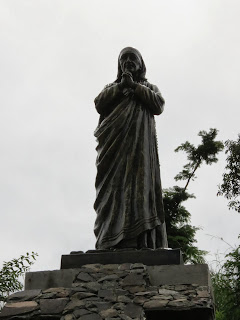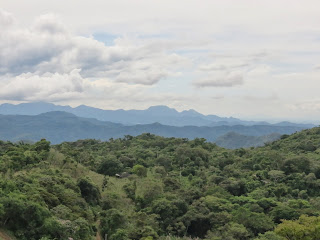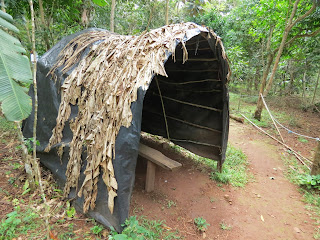Today was a long and exhausting day both mentally
and physically. We were going to visit the massacre site of El Mozote and a
guerilla war museum in Perquin. Alfredo came to pick us up at 7:00am and then
we were off on a 2½ hour ride to the department of Morazán. The
following is a description of the events at El Mozote. It comes from several
sources, including information at the site and testimony by survivor Rufina
Amaya. I want to forewarn you that the story is graphic and disturbing.
The Massacre at El Mozote
The El Mozote Massacre took place in the village of El Mozote, in Morazán, El Salvador, on December
11, 1981, when Salvadoran armed forces trained by the United States military
killed at least 1000 civilians in an anti-guerrilla
campaign. It is reputed to be one of the worst such atrocities in modern Latin America
history.
It began on the afternoon of December 10, 1981, when units
of the Salvadoran army’s Atlacatl
Battalion arrived at the remote village of El Mozote. The Atlacatl
was a “Rapid Deployment Infantry Battalion” specially trained for counter-insurgency
warfare. It was the first unit of its kind in the Salvadoran armed forces and
was trained by United States military advisors. Its mission, Operación Rescate, was to eliminate
the rebel presence in a small region of northern Morazán where the FMLN (guerillas) had a camp and a training
center. The commander of the Battalion was Lieutenant Colonel Coronel Domingo
Monterrosa Barrios, who was from Berlín.
In the afternoon of December 10th the five
companies of Atlacatl Battalion arrived in El Mozote. Upon arrival, the
soldiers found not only the residents of the village but also campesinos
(rural people) who had sought refuge from the surrounding area. The campesinos
had gone to El Mozote thinking it would be a safe place. The soldiers ordered
everyone out of their houses and into the square. They made them lie face down,
searched them, and questioned them about the guerrillas. They then ordered the
villagers to lock themselves in their houses until the next day, warning that
anyone coming out would be killed. The soldiers remained in the village during
the night.
Early the next morning, on December 11th, the
soldiers reassembled the entire village in the square. They separated the men
from the women and children and locked them all in separate groups in the
church, the convent, and various houses. At 8:00am the executions began.
Throughout the morning, they proceeded to interrogate, torture, and execute the
men and adolescent boys in several locations. Around noon, they began taking
the women and older girls in groups, separating them from their children and
machine-gunning them after raping them.
Girls as young as 9 were raped and tortured, under the pretext of them being
supportive of the guerillas. Finally, they killed the children. A group of
children that had been locked in the church and its convent were shot through
the windows. Some of the younger children were thrown up into the air and the
soldiers speared them on their bayonets. After killing the entire population,
the soldiers set fire to the buildings and many of the bodies. Over 1000 people
perished.
The massacre at El Mozote was part of a military strategy of
genocide against the Salvadoran people. The government and army exterminated
massive numbers of innocent campesinos (country people) in the war zones. The
thought was to “take away the water from the fish”. As a result, many massacres
of hundreds of rural families were carried out in various places in the
country. The operations were known as “Scorched Earth” or “Land Clearing
Operations”.
The guerrillas' clandestine radio station began broadcasting
reports of a massacre of civilians in the area. On December 31, the FMLN issued
“a call to the International Red Cross, the OAS Human Rights Commission, and
the international press to verify the genocide of more than 900 Salvadorans” in
and around El Mozote. Reporters started pushing for evidence.
Officials from the US embassy in San Salvador played down
the reports and said they were unwilling to visit the site because of safety
concerns. As news of the massacre slowly emerged, the Reagan administration in the United States
attempted to dismiss it as FMLN (guerilla) propaganda because it had
the potential to seriously embarrass the United States government because of its reflection of
the human rights abuses of the Salvadoran government, which the US was
supporting with large amounts of military aid
(over 1 million dollars per day).
It wasn’t until 1992, the year the Peace Accords were
signed, that a team of forensic anthropologists were allowed to examine the
convent in El Mozote. 140 children were found in that area. They determined
that twenty-four shooters killed the children, using M-16 rifles and bullets
manufactured in the US. The forensic experts concluded that it was a mass
execution, and not the guerilla burial ground the Salvadoran government claimed
it to be.
The monument at El Mozote
They have not died, they are with us,
with you, and with all humanity.
Our guide telling us the story of the massacre
Rufina
Amaya’s story
Rufina Amaya was the only survivor of the massacre. When it
came time to execute the women, she stood last in line because she wouldn’t let
go of her children. After her daughter was taken from her and the men weren’t
watching, she hid nearby, praying the whole time for God to protect her. She
stayed there a long time until she had the courage to crawl many miles to
safety. No words or pictures could possibly describe how she felt that day:
Listening to the screams of her husband being tortured and dying, having her
children ripped from her arms and ruthlessly slaughtered. On December 11, 1981
she lost her husband and four children, aged 9 years, 5 years, 2 years, and 8
months.
Rufina's grave
A photo of Rufina
Rufina's family members that were killed
Children’s
Garden
We weren’t able to go see the Children’s Garden today, but I
wanted to include some information and pictures because I believe they are
important. During the massacre, the children were all put into a room attached
to the church. Here they were killed and the building set on fire. A small
garden now grows where they found the remains of the children.
On the side of the church inside the garden are the names of
all the children that were killed in the massacre and their ages. Most were
under 12 years old. The youngest child killed was 2 days old, though there was
a pregnant woman in her third trimester who was found with the murdered women. While
many names are on the wall several children’s names will be forever unknown. Entire
families were killed in the massacre and the names of their children are not
known. They are listed on the wall as “Son of…” or “Daughter of…” while others
are listed “Grandson of…” or “Niece of….” However, there are also several
children who are listed only as “Name unknown.” It’s sad to think that these
beautiful children suffered such a horrible death and we will never know who
many of them are.
The Children's Garden
Names of children
Many children remain unknown
The remains of 140 children were found here
El
Mozote Foundation
There is a group of women that run the El Mozote Foundation
which helps keep the area maintained and ensures the story is still being told.
Then we walked to the little artisan store that’s run by the women of the
Foundation. I got a couple rosaries, some jewelry, and soap. I also took pictures of a couple cute little boys I saw. As we left we saw two bus loads of young people going to hear the story of El Mozote. Then we were off
to out next destination.
Artisan store
Cute little boys!
Lots of young people
Project
of Peace and Reconciliation
The next place we went was a monument dedicated to
peace and reconciliation. This is a relatively new monument and I had never
been there before. It was just constructed this year and is not finished yet. They
are still going to build a Spiritual Center and a Chapel in the area. The
project is funded in part by a seminary student who was associated with El
Salvador and Germany. He felt the need to raise funds and build the monument.
In addition to a statue of Jesus Christ in the middle of the monument, there
are also statues of Martin Luther King, Mahatma Gandhi, Mother Teresa, and Pope
John Paul II. They are also starting to build a small park for children with a
statue of St. Francis of Assisi in the middle. After looking around we stood
together beneath the monument and listened to a prayer from Balmore
Then Michelle, Katherine, Blanca, Balmore, Idalia,
and I make the trek up to the top of a large hill to see the statue of Romero
and the view from above. It was a rough hike but definitely worth it. The view
was spectacular! The statue was incredible and you could see for miles. We just
stood and took it all in.
The Monument of Peace and Reconcilication
Sign about the project
Martin Luther King
Pope John Paul II
Mother Teresa
Mahatma Gandhi
Jesus Christ
St. Francis of Assisi
Romero up on top of a hill
Walking up to see the Romero statue
Looking down
Oscar Romero
View from above
Perquin:
Museum of the Revolution
Our next stop was the town of Perquin. Perquin was under FMLN
guerilla control during the Civil War and was known as part of the “red zone”.
First we visited the Museum of Salvadoran Revolution. It contains documents,
articles, pictures, and artifacts that belonged to the guerillas during the
Civil War. The museum was founded by ex-combatants and attempts to recount the
experiences of the guerillas.
After looking through the inside of the museum we walked
outside to see the remains of helicopters and airplanes. Probably the most
famous is the wreckage of the helicopter of Colonel
Domingo Monterrosa, who was the commander of the Battalion that massacred the
people in El Mozote. It was blown up by the guerillas in 1984. We also saw
a recreation of Radio Venceremos, which was a mobile guerilla radio station
during the war. Inside the recreated radio station is part of the device that
was used to destroy Monterrosa’s helicopter.
Naked Innocence, Faceless Repression
Poverty: A major cause of the war
The FMLN was named after this man
Signs during the Civil War
Drawings by children about the war
Women were also guerillas
Strategic plan of attack
Guerillas
Remnants of planes and helicopters
Cars given to the guerillas
Returning home after the war
Radio Venceremos during the war
A 500 pound bomb given to the government to
"help fight the communist guerillas."
Compliments of the USA
Guerilla
Encampment
Next we went to Campamento Guerrillero, which was a recreation
of a guerilla camp. I’ve been there several times before and loved it. First we saw some of the weapons they used
during the war including grenades, machine guns, and machetes. We walked on to
see two recreated “tents” where the guerillas could stay dry when it rained.
Then we went to the “kitchen” area which they tried to hide so as not to be
seen by the military. Over the kitchen was a roof of leaves and a pipe
underground carried the smoke far from the kitchen. After that we saw the
“hospital” area. The gurney was essentially large leaves wrapped around sticks
that were being held up by pieces of wood. Our guide showed us the “ambulance”:
a hammock. The first time I saw it the former mission co-worker had asked me,
“Could you imagine being operated on here?” I responded, “I think I’d rather
die.” Then we walked on to a hole in the ground with a ladder coming out of it.
It led down to an underground chamber and tunnel. This was a place the
guerillas would have hidden if there were helicopters overhead.
Next we came upon two bridges. These were replicas of
bridges that the guerillas would have built while in the area. Both bridges
were made of wood and rope over high ravines. After looking at a sign that
said, “Only 2-3 people at once on the bridge” and “We’re not responsible if you
fall” we crossed over the first bridge. Everyone did very well and no one fell
off. The second bridge swayed and dipped down quite a bit when we walked on it,
but we made it.
The last thing I did was go across a large ravine on a zipline
swing. Michelle called it a “crazy grill swing” on which you could either
barbque on swing across the jungle. It was only $2 and totally worth it. As I
flew across the ravine I shouted in Spanish, “Faster, faster!” I wish I could
have taken my camera with me but I forget in all the excitement.
Guerilla Encampment
Parts of the radio
A door from El Mozote
Shelter that the guerillas used
Explaining how radios worked
The "hospital"
A hiding place
Going down
Adios Michelle!
And coming out
Hola!
Going down again
Across the bridges they go
Maggy leads the way!!

The second bridge
The zipline swing/grill
I'm ready!!
And I'm off!
Safely off the swing
Lunch
at Perkin Lenca
We ate lunch at our usual spot: Perkin Lenca. It felt good
to sit down and have a rest. I ordered horchata (a rice drink) and chicken
tacos. Everything was delicious, especially after all that walking. Everyone
was quiet as we eat; a sure sign of good food. We started our drive back to the
house by 2:30pm.
The restaurant
When we got back to the house, Maggie, Michelle, and I went
for a short walk around town before settling into the house for the night. I
ran into a couple people I knew which was nice. Dinner tonight was pupusas
which were delicious. I ate mine much later because I’d stopped to get ice
cream in town.
Around 6:30pm we sat down with the Pastoral Team to reflect
on our day. We all talked about what we felt were the low and the high points of
the day. For me, the low of the day was thinking about all the girls and women
that were brutally raped by the army. I can’t even begin to imagine the mental
and physical suffering they must have felt. And then watching and hearing their
friends and family being raped as well? How awful!! What sickness must exist
inside someone to commit such atrocities. What’s worse is that this occurred
all over El Salvador during the war. It has occurred all over the world in
every country during times of war and conflict. Rape has been used for hundreds
of years as a way to dominate and control women. And it continues to this very day.
We’ve come so far as a society and so far in the world, yet the violence
against women continues. It truly sickens me.
The high point of the day was seeing two buses full of young
people at El Mozote. How wonderful that the youth in the country are learning
about and hearing the story of the massacre. This gives me hope for the future
that these atrocities will not occur again.
Hay que recordar para no repetir. One must remember in order not to repeat.















































































1 comment:
A long and difficult day to be sure. El Mozote is one those places that is so important to learn about and remember yet is so incredibly difficult at the same time. That new monument is really great.
Post a Comment